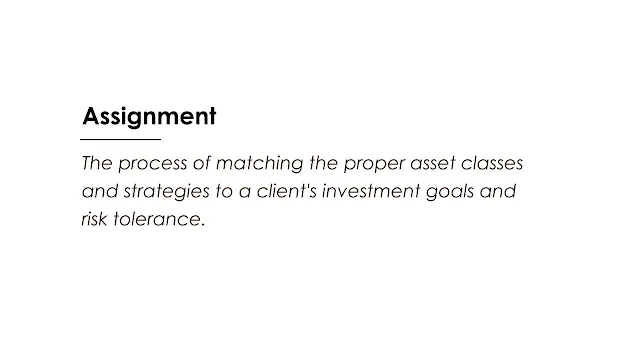 |
| Image: Moneybestpal.com |
The process of investing and managing money on behalf of customers, including pension funds, endowments, foundations, insurance companies, and individuals, is known as asset management. Asset managers distribute their capital among several asset classes, such as equities, bonds, commodities, real estate, and alternative assets, in an effort to create returns for their clients.
Assignment is a crucial idea in asset management. Assignment describes the process of matching the proper asset classes and strategies to a client's investment goals and risk tolerance. An assignment is essential for satisfying customer expectations and attaining the best performance for your portfolio.
Assignments can be approached in a variety of ways based on the type of customer and the level of customization needed. Some of the common approaches are:
- Strategic asset allocation: This is the long-term asset allocation determined by the anticipated returns, risks, and correlations of several asset classes over a period of several years. The allocation of strategic assets is typically decided using scenario analysis, economic models, and historical data. The objective is to build a diversified portfolio that can survive a variety of market circumstances and achieve the client's desired return and risk profile.
- Tactical asset allocation: According to the opportunities and market conditions at the time, assets were adjusted in the short term. Market indicators like as valuation, momentum, mood, and macroeconomic considerations are frequently used to inform tactical asset allocation. By benefiting from market oddities and inefficiencies, the aim is to improve portfolio performance.
- Dynamic asset allocation: Combining tactical and strategic asset allocation, this approach offers more adaptability and responsiveness to shifting market conditions. A system of rules or algorithms is typically the foundation of dynamic asset allocation, which modifies the portfolio weights in response to predetermined triggers or thresholds. In creating a portfolio, it is intended to strike a balance between stability and adaptability.
- Factor-based asset allocation: In contrast to the conventional asset classes, this alternative asset allocation strategy concentrates on the fundamental factors that influence returns. Using factors including value, growth, quality, momentum, size, volatility, liquidity, and yield, factor-based asset allocation pinpoints and takes advantage of common sources of risk and returns across various assets. In order to reduce idiopathic and unrewarded risks, it is necessary to capture the systematic and diverse exposure to these factors.
As the world's largest asset manager by AUM BlackRock has extensive experience and expertise in assignment. BlackRock offers a range of solutions for different types of clients and their specific needs. Some of these solutions are:
- BlackRock Model Portfolios: These pre-packaged portfolios offer diverse exposure to different asset classes and investment philosophies based on varying risk appetites and time horizons. The Portfolio Solutions team at BlackRock uses its in-house technology, analytics, and research platforms to create BlackRock Model Portfolios. The Investment Institute at BlackRock updates them every three months to reflect the most recent market perceptions and knowledge.
- BlackRock Aladdin: An all-encompassing platform for investment management, it offers extensive tools and services for building portfolios, managing risks, trading, running businesses, complying with regulations, and reporting. In order to assist clients in streamlining their assignment procedures and improving the results of their portfolios, BlackRock Aladdin makes use of BlackRock's data, analytics, and technological capabilities.
- BlackRock Digital Assets: Using blockchain technology and digital assets, this new venture investigates the potential of asset management. By connecting to Coinbase Prime, a prominent cryptocurrency trading, custody, prime brokerage, and reporting platform, BlackRock Digital Assets hopes to give institutional clients direct access to digital assets, starting with Bitcoin. In an effort to diversify its alternative investing options, BlackRock Digital Assets recently introduced a private trust that aims to track the performance of Bitcoin.
Assignment is a crucial idea in asset management that needs thoughtful planning and execution. Asset managers can add value for their clients and aid in the achievement of their financial objectives by applying various methods and solutions for assignments.
